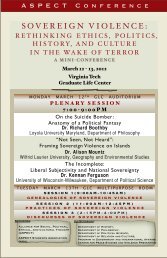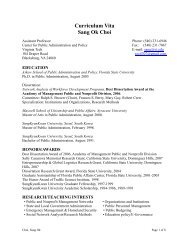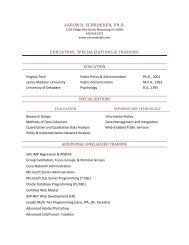1 Towards a Critical Social Theory of Philanthropy in an Era of ...
1 Towards a Critical Social Theory of Philanthropy in an Era of ...
1 Towards a Critical Social Theory of Philanthropy in an Era of ...
You also want an ePaper? Increase the reach of your titles
YUMPU automatically turns print PDFs into web optimized ePapers that Google loves.
<strong>Phil<strong>an</strong>thropy</strong> as the Affirmative <strong>Social</strong> <strong>Theory</strong> <strong>of</strong> Marg<strong>in</strong>ality<br />
The uncritical assumptions underly<strong>in</strong>g phil<strong>an</strong>thropy today are that it symbolizes<br />
benevolence <strong>an</strong>d that its aim is to end marg<strong>in</strong>ality (see Byrne 2002; The Economist 2004, 2006a,<br />
2006b, 2006c; Gibbs 2005/2006; Poniewozik 2005/2006). Yet, <strong>in</strong> practice, phil<strong>an</strong>thropy is<br />
frequently constructed <strong>an</strong>d supported by the very th<strong>in</strong>g that it claims to end – marg<strong>in</strong>ality.<br />
<strong>Phil<strong>an</strong>thropy</strong> is dependent upon the existence <strong>of</strong> marg<strong>in</strong>al groups <strong>in</strong> need <strong>of</strong> assist<strong>an</strong>ce <strong>an</strong>d a<br />
more powerful group <strong>in</strong> a position to <strong>of</strong>fer this assist<strong>an</strong>ce. Thus, when we discuss phil<strong>an</strong>thropy<br />
we assume that some level <strong>of</strong> <strong>in</strong>equity exists <strong>an</strong>d this <strong>in</strong>equity is natural. In other words,<br />
discussions <strong>of</strong> how phil<strong>an</strong>thropy might be encouraged <strong>an</strong>d susta<strong>in</strong>ed are simult<strong>an</strong>eously<br />
discussions about how the system, whatever it is <strong>an</strong>d wherever it is, c<strong>an</strong>not be ch<strong>an</strong>ged such that<br />
the need for phil<strong>an</strong>thropy would be elim<strong>in</strong>ated.<br />
Marg<strong>in</strong>ality as affirmative social theory, or what M<strong>an</strong>del (1972) discusses as <strong>in</strong>tegration,<br />
is based <strong>in</strong> metaphysics, or “the sett<strong>in</strong>g up <strong>of</strong> norms which are given out to be self-evident<br />
(because derived from such unquestionable truths are consciousness, presence, nature, life, <strong>an</strong>d<br />
ownership) <strong>an</strong>d the marg<strong>in</strong>alization <strong>of</strong> <strong>an</strong>yth<strong>in</strong>g that puts the norm <strong>in</strong> question” (Ry<strong>an</strong> 1982,<br />
126). <strong>Phil<strong>an</strong>thropy</strong> as a cop<strong>in</strong>g strategy for deal<strong>in</strong>g with the problems <strong>of</strong> marg<strong>in</strong>ality is what<br />
Michael Ry<strong>an</strong> (1982) has called “the social theory <strong>of</strong> marg<strong>in</strong>ality” (126). Build<strong>in</strong>g on J<strong>an</strong>ice<br />
Perelm<strong>an</strong>’s The Myth <strong>of</strong> Marg<strong>in</strong>ality (1976), Ry<strong>an</strong> (1982) argues that the br<strong>an</strong>d<strong>in</strong>g <strong>of</strong> marg<strong>in</strong>als<br />
acts as a metaphysical justification <strong>of</strong> repression (126): “Metaphysically <strong>in</strong>formed social<br />
theories, <strong>in</strong> the h<strong>an</strong>ds <strong>of</strong> the rul<strong>in</strong>g classes, become social policy” (127). This is so because, for<br />
Ry<strong>an</strong> (1982) “metaphysics is the <strong>in</strong>frastructure <strong>of</strong> ideology” (117), particularly where, as <strong>in</strong> the<br />
case <strong>of</strong> phil<strong>an</strong>thropy, it enters “the doma<strong>in</strong> <strong>of</strong> practice” (118).<br />
11






